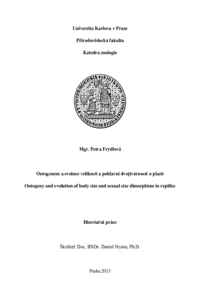Ontogeneze a evoluce velikosti a pohlavní dvojtvárnosti u plazů
Ontogeny and evolution of body size and sexual size dimorphism in reptiles
rigorous thesis (RECOGNIZED)

Reason for restricted acccess:
The annexes of the thesis or its part are inaccessible in accordance with article 18a (7) of The Code of Study and Examination in conjunction with Article 9 of the Rector’s Directive No. 6/2010.
View/
Permanent link
http://hdl.handle.net/20.500.11956/56987Identifiers
Study Information System: 147672
CU Caralogue: 990016853480106986
Collections
- Kvalifikační práce [20949]
Author
Faculty / Institute
Faculty of Science
Discipline
Zoology
Department
Department of Zoology
Date of defense
17. 2. 2014
Publisher
Univerzita Karlova, Přírodovědecká fakultaLanguage
Czech
Grade
Recognized
Keywords (Czech)
pohlavní dvojtvárnost, evoluce velikosti, růst, šupinatí plaziKeywords (English)
sexual size dimorphism, evolution of body size, growth, squamateSkupina Varanidae je tvarově velmi uniformní, ale velikostně vykazuje obrovskou variabilitu, a to jak na fylogenetické tak i na ontogenetické úrovni. Pohlavní dvojtvárnost ve velikosti (SSD) je u varanů velmi výrazná, tato skupina je schopna velmi rychlého růstu, metabolismu a pohlavního dospívání. Na základě dat o velikosti jednotlivých druhů se mi podařilo ověřit platnost Renschova pravidla, kdy s rostoucí velikostí druhu se zvětšuje rozdíl ve velikosti samců a samic, samci jsou nápadně větším pohlavím. V dalším kroku jsem se již zaměřila na modelový druh varana mangrovového (Varanus indicus). Sledovala jsem velmi detailně jeho ontogenezi. Zjistila jsem, že je tento varan poměrně značně dimorfní ve velikosti a částečně i ve tvaru těla, je schopný enormně rychlého růstu a pohlavního dospívání. Oproti velikostní pohlavní dvojtvárnosti je tvarová jen slabá, avšak měřitelná v těch místech, kde byl předpokládán selekční tlak. Odběry krve sledovaly biochemické a hematologické parametry. Koncentrace biochemických parametrů poodhalily hospodaření jednotlivých pohlaví se zdroji, nákladnost růstu a reprodukce. Ačkoliv obě pohlaví produkují obdobné množství biomasy (růst samců vs. reprodukce samic), zdá se, že investice do reprodukce jsou kvalitativně náročnější. Hodnocením hematologických parametrů jsem...
Monitor lizards (Varanidae) are morphologically very uniform in body shape, but much diversified in body size along both phylogenetic and ontogenetic axes. A striking sexual size dimorphism exists in monitor lizards; they are capable of fast growth, metabolism and sexual maturation. I collected the data concerning body size of particular species and verified the validity of Rench's rule, which said that there is bigger difference in body size of a conspecific male and females growing with larger body size of the species. Males are markedly bigger than females. In the next step, I focused on the model species of monitor lizards, Varanus indicus. I monitored its ontogeny very carefully. I found that this monitor lizard has pronounced sexual size dimorphism, but there are only small differences in body shape. It is capable of rapid growth and sexual maturation. The sexual dimorphism in body shape is only poor, but still measurable right in those places where the selection pressures were expected. Blood sampling monitored biochemical and haematological parameters. The concentrations of the biochemical parameters revealed the economy of resources of particular sexes partially, the costs of body growth and reproduction. Although both sexes produce the same amount of biomass (the body growth of males vs....
